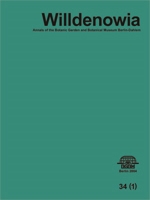Oberprieler, C.: On the taxonomic status and the phylogenetic relationships of some unispecific Mediterranean genera of Compositae-Anthemideae I. Brocchia, Endopappus and Heliocauta. — Willdenowia 34: 39–57. — ISSN 0511-9618; © 2004 BGBM Berlin-Dahlem.
Sequences of the nrDNA internal transcribed spacer (ITS) region and the cpDNA trnL/trnF intergenic spacer (IGS) region were analysed for 67 representative species of 54 genera of Compositae-Anthemideae to ascertain the systematic position of the three unispecific Mediterranean genera Brocchia, Endopappus and Heliocauta. For Brocchia cinerea, which was considered to be closely related to Cotula due to its 4-lobed corolla of disc florets, a position among Mediterranean genera clearly distinct from Cotula but with unresolved sister group relationships is demonstrated. For Endopappus macrocarpus a close relationship with Tripleurospermum was suggested due to similarities in achene morphology; the molecular data, however, support its position distinctly distant from Tripleurospermum and among genera with a western Mediterranean centre of distribution characterized by a 5bp deletion in the trnL/trnF IGS. For Heliocauta atlantica, which was hitherto placed in the vicinity of Hippolytia from central Asia, the molecular data reveal its sister group relationship with the strictly Mediterranean genus Anacyclus. First efforts are made to date the diversification of members of the tribe based on sequence divergence rates (c. 1 % = 0.75 Myr) and assuming an origin of the tribe in the Middle Oligocene (c. 25 Myr). It is concluded that lineages within the clade of Mediterranean and Eurasian representatives characterized by a 17bp deletion in ITS2 diverged in the Middle Miocene (c. 15 Myr).





